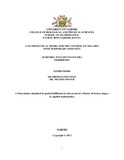| dc.description.abstract | Malaria is an infectious disease transmitted between humans through mosquito bites that kill about two million people a year. Many infectious diseases including malaria are preventable, yet they remain endemic in many countries like Kenya due to lack of proper, adequate and timely control policies. The main goal of this project is to develop a mathematical model for the control of malaria. It has been shown that the model has unique disease- free and endemic equilibria.
A mathematical model for malaria is developed using ordinary differential equations. We
analyze the existence and stability of disease-free and endemic malaria (malaria persisting in the population) equilibria. Key to our analysis is the definition of a reproductive number Ro (the number of the new infections caused by one individual in an otherwise fully susceptible population) through the duration of the infectious period.
The methods for controlling any infectious disease include a rapid reduction in both the infected and susceptible populations as well as a rapid reduction in the susceptible class if a cure is available. For diseases of malaria where there are no vaccines, it is still possible to reduce the susceptible group through a variety of control measures.
The disease-free equilibrium is locally asymptotically stable, if Ro < 1, and we also note that when Ro > 1, the disease-free equilibrium is unstable and the endemic equilibrium is stable. Numerical simulations show that recoveries and temporary immunity keep the populations at
oscillation patterns and eventually converge to a steady state.
Further simulation of the model clearly shows that, with proper combination of treatment and concerted effort aimed at prevention, malaria could be eliminated from our society. In fact, effective treatment offered to about fifty percent of the infected population together with about fifty percent prevention rate is all that is required to eliminate the diseases. | en |

